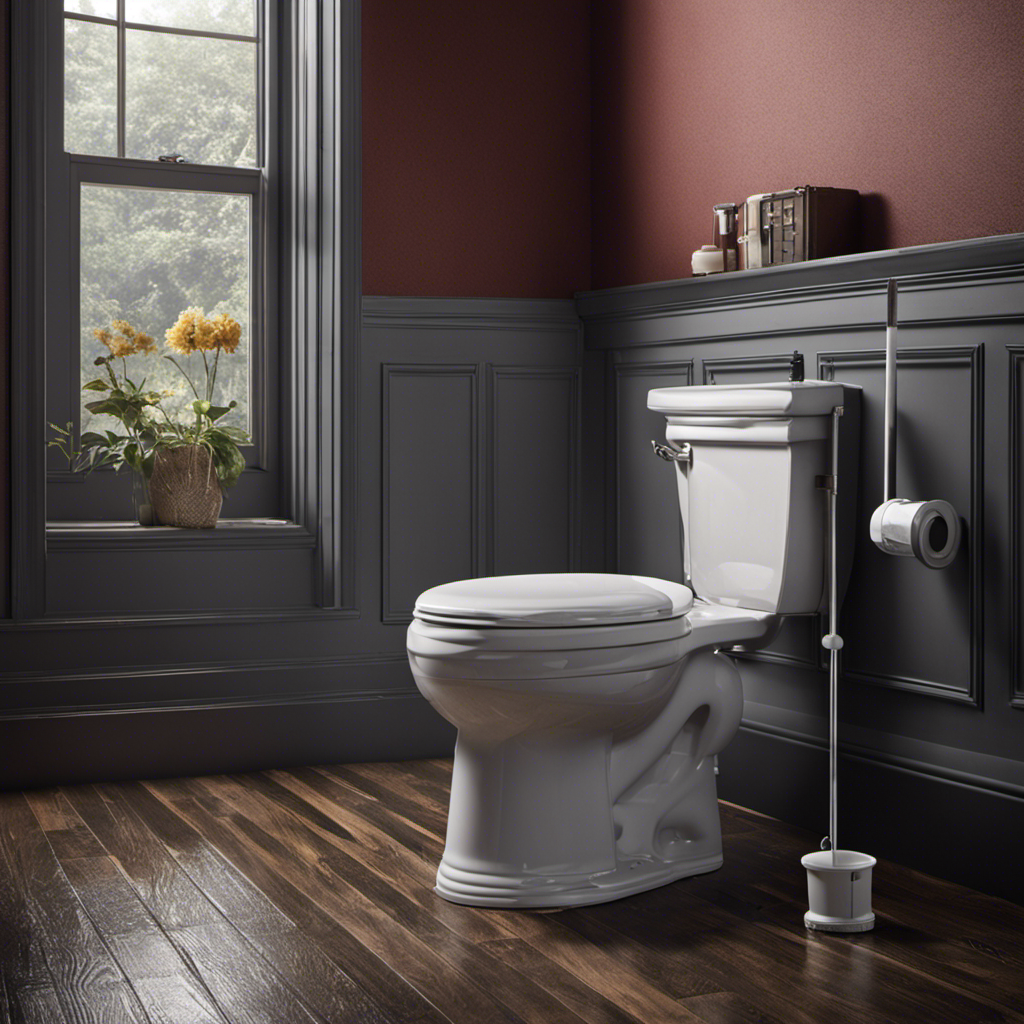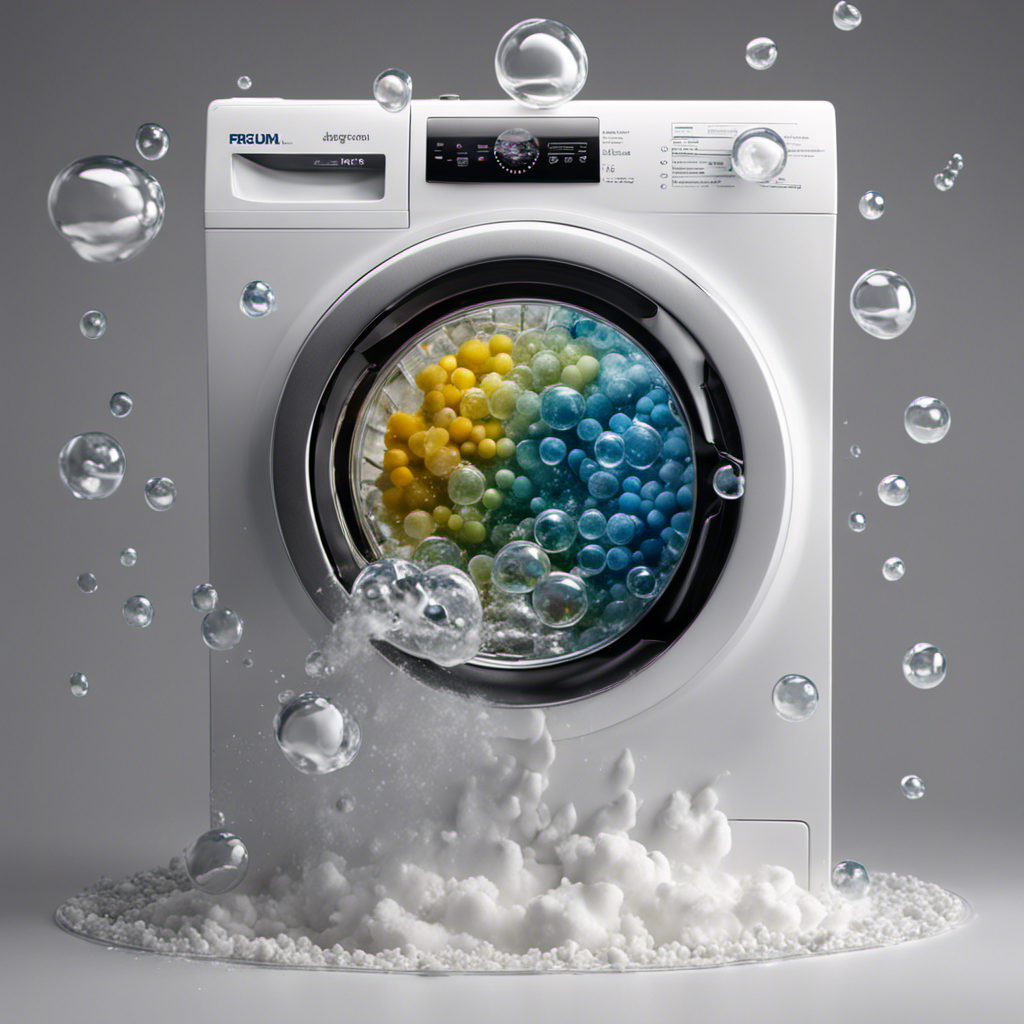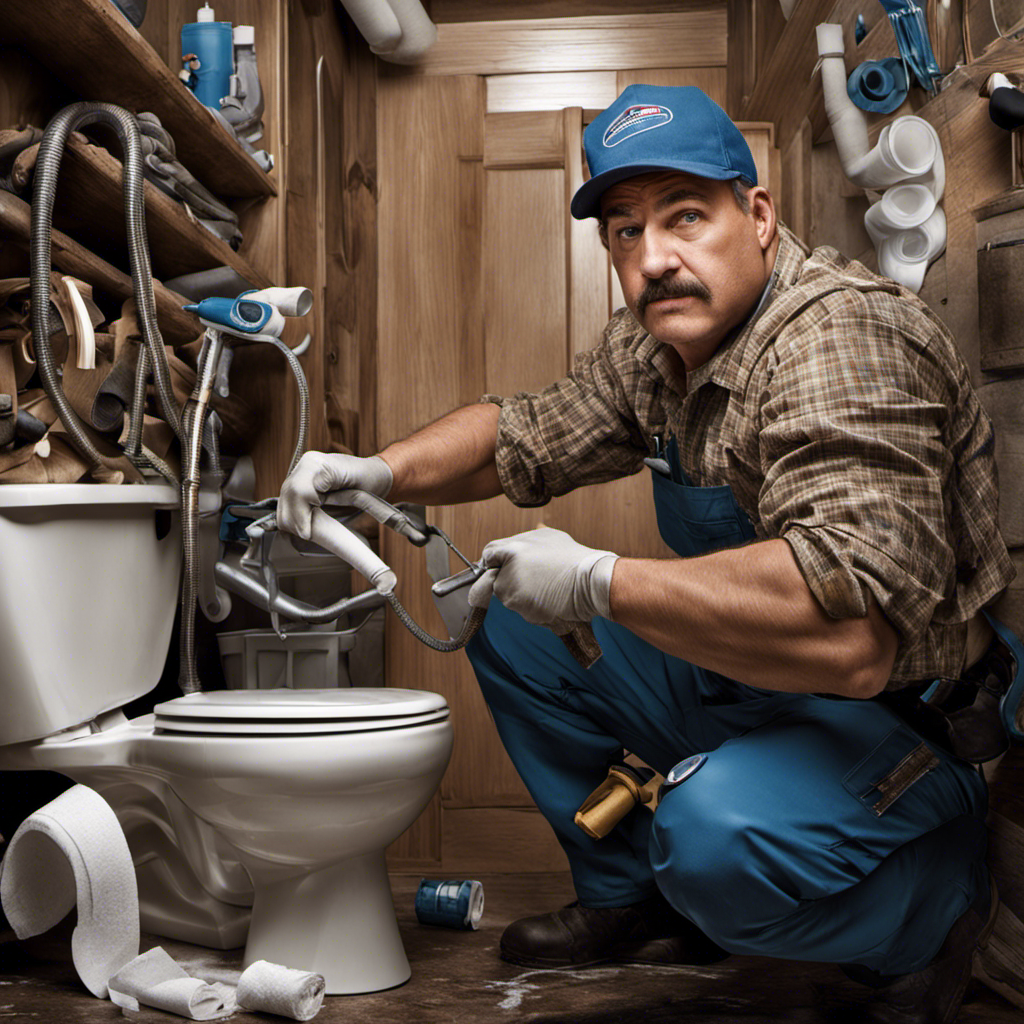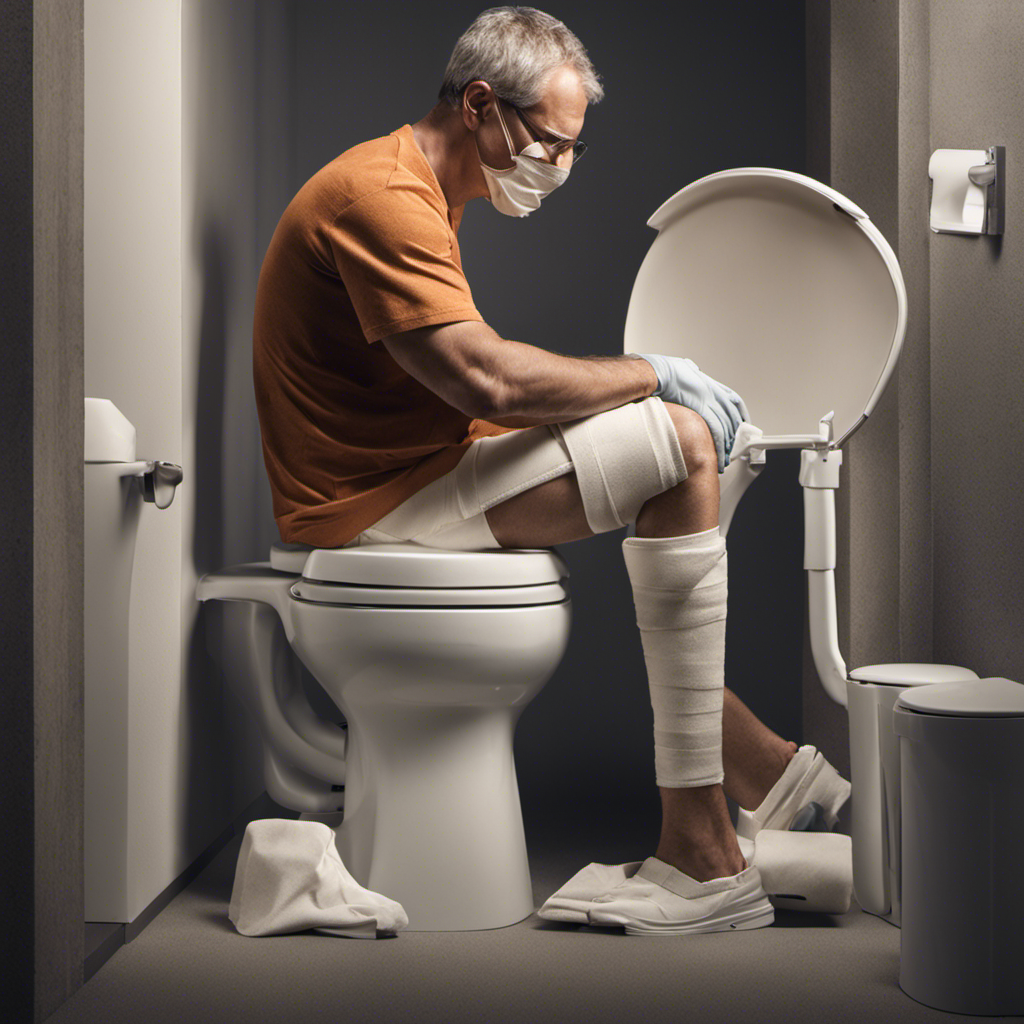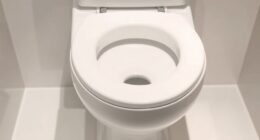Hey there! Ever had the frustrating experience of a toilet with water levels that just won’t go down? Trust me, I’ve been there. But don’t worry, because in this article, I’m going to break down the causes, effects, and solutions for this annoying plumbing problem.
We’ll dive into issues like clogged drain pipes, malfunctioning flapper valves, and faulty fill valves. I’ll even give you some DIY tips to try out.
So, let’s get started and fix that high toilet water level once and for all!
Key Takeaways
- Clogged drain pipes, malfunctioning flapper valve, faulty fill valve, and blocked vent pipe are some common causes of high toilet water levels.
- The effects of high toilet water levels include overflowing toilet bowl, water damage to the bathroom floor, increased risk of sewage backup, and potential health hazards.
- Solutions for high toilet water levels include clearing clogged drain pipes, adjusting or replacing malfunctioning components, regular cleaning and maintenance, and seeking professional help for persistent issues.
- Preventive measures to avoid high toilet water levels include proper disposal of waste, regular cleaning and maintenance, installation of a drain strainer, and conducting regular plumbing inspections.
Clogged Drain Pipes
I can try using a plunger to remove clogs if I suspect that clogged drain pipes are causing the high toilet water level. Clearing clogged pipes can be done as a DIY project or with professional help.
If you choose to do it yourself, start by using a plunger to create suction and dislodge the blockage. Make sure to cover the drain opening completely and plunge vigorously. If this doesn’t work, you may need to consider using a toilet auger or snake to break up the clog.
However, if the clog persists despite your DIY efforts, it is advisable to seek professional help.
To prevent clogged drain pipes, avoid flushing excessive toilet paper or non-flushable items. Regularly clean and maintain the toilet, and consider installing a drain strainer to catch debris. Conducting regular plumbing inspections can also help identify and prevent potential clogs in the drain pipes.
Malfunctioning Flapper Valve
To fix a malfunctioning flapper valve, simply adjust it for proper sealing. Here are the steps to follow for adjusting the flapper valve:
-
Turn off the water supply to the toilet by shutting off the valve located behind the toilet.
-
Lift the toilet tank lid and locate the flapper valve. It is usually a rubber or plastic piece at the bottom of the tank.
-
Check for any visible signs of damage or wear on the flapper valve. If necessary, replace it with a new one.
-
Adjust the chain or strap that connects the flapper valve to the flush lever. Make sure there is enough slack for the flapper valve to fully close but not too much that it gets tangled or caught.
-
Test the flush by flushing the toilet and observing if the flapper valve seals properly after each flush.
Regular maintenance of the flapper valve is essential to prevent water leakage and ensure efficient flushing.
Faulty Fill Valve
The faulty fill valve can cause the toilet water level to rise excessively. This can lead to overflowing toilet bowls, water damage to the bathroom floor, and an increased risk of sewage backup.
To troubleshoot this issue, there are a few steps you can take. First, check if the fill valve is adjustable and ensure it is set to the correct water level. If it is not adjustable or adjusting it doesn’t solve the problem, it may be necessary to replace the fill valve altogether.
Replacement options include traditional ballcock fill valves or newer, more efficient fill valves. When replacing the fill valve, make sure to turn off the water supply, drain the tank, and follow the manufacturer’s instructions for installation.
Blocked Vent Pipe
Blocked vent pipes can lead to a variety of issues with the toilet, such as a high water level, frequent clogs, and foul sewage odor in the bathroom. To address this problem, there are several potential solutions for a blocked vent pipe:
- Use a plumber’s snake to remove blockages
- Clear the vent pipe with a high-pressure water jet
- Install a vent pipe extension to increase airflow
- Remove any debris or nests from the vent pipe
- Check for any structural issues or obstructions in the vent pipe
To prevent vent pipe blockages in the first place, it is important to take certain precautions:
- Avoid flushing non-flushable items down the toilet
- Regularly clean and maintain the plumbing system
- Install a vent pipe screen to prevent debris from entering
- Conduct regular inspections to catch any potential issues early on
- Seek professional help if you suspect a blockage or any other plumbing problem that you’re unable to resolve on your own.
Improperly Adjusted Float
I can adjust the float to control the water level in the toilet. The float mechanism plays a crucial role in maintaining the proper water level and preventing overflow. When the float is improperly adjusted, it can lead to a high water level in the toilet bowl.
Troubleshooting float issues involves understanding how the float works and making the necessary adjustments. By adjusting the float, you can regulate the amount of water that enters the toilet tank after each flush. This ensures that the water level remains at an optimal level, preventing any potential issues such as overflowing or inadequate flushing.
If you notice a high water level in your toilet bowl, adjusting the float should be one of the first steps you take to resolve the problem.
Overflowing Toilet Bowl
When my toilet bowl overflows, it creates a messy and potentially damaging situation. It’s important to know how to prevent toilet bowl overflow and the ways to fix it without calling a plumber. Here are some tips:
- Check for clogged drain pipes and use a plunger to remove the clogs.
- Inspect the flapper valve and adjust it for proper sealing or consider replacing it.
- Examine the fill valve for any faults and replace it if necessary.
- Clear blockages in the vent pipe to ensure proper drainage.
- Adjust the float to control the water level in the tank.
By following these preventive measures and DIY solutions, you can avoid the inconvenience and expense of a plumber.
Remember to avoid excessive toilet paper, conduct regular plumbing inspections, and clean the toilet regularly to prevent future overflow issues.
Water Damage to Bathroom Floor
Experiencing water damage on my bathroom floor can lead to costly repairs and potential safety hazards. When high toilet water levels cause overflow, the excess water can seep into the flooring, causing damage to the tiles, subfloor, and even the structural integrity of the bathroom.
Prevention methods are crucial in avoiding such situations. Regularly inspecting and maintaining the toilet, using a drain strainer to prevent clogs, and avoiding flushing excessive toilet paper or non-flushable items can help prevent water damage to the bathroom floor.
However, if water damage does occur, the repair cost estimation can vary depending on the extent of the damage. It is recommended to seek professional help to assess the damage and provide an accurate repair cost estimation, as well as to ensure the safety and longevity of the bathroom.
Increased Risk of Sewage Backup
One potential consequence of a high toilet water level is an increased risk of sewage backup. This can be a serious problem that requires immediate attention to prevent further damage and potential health hazards. To prevent sewage backup, it is important to take appropriate measures and consider professional sewage backup services if necessary.
- Regularly clean and maintain the toilet to prevent clogs and blockages.
- Avoid flushing excessive toilet paper and non-flushable items.
- Install a drain strainer to catch debris and prevent clogs.
- Conduct regular plumbing inspections to identify any potential issues.
- Seek professional help if DIY solutions are not effective or if there are persistent high water levels and frequent backups.
Preventing sewage backup is crucial to maintain a functional and safe plumbing system. Professional sewage backup services can provide expert assistance in resolving these issues and ensuring the proper functioning of your toilet and overall plumbing system.
Unpleasant Odor
I can detect an unpleasant odor coming from the toilet, indicating a potential issue that needs to be addressed.
When it comes to toilets, unpleasant odors can be caused by various factors, including the use of certain toilet bowl cleaners and problems with ventilation systems.
Toilet bowl cleaners often contain chemicals that, while effective at cleaning, can produce strong odors that linger in the bathroom. Additionally, inadequate ventilation systems can result in stagnant air, allowing odors to accumulate.
To address this issue, it is essential to choose toilet bowl cleaners that are less likely to produce strong odors and ensure that the bathroom has proper ventilation. This can be achieved by using exhaust fans or opening windows to allow fresh air to circulate.
Regularly cleaning the toilet and maintaining the ventilation system can also help eliminate unpleasant odors.
Potential Health Hazards
The potential health hazards associated with a high toilet water level should not be overlooked. Sewage backup can pose serious health risks, as it contains harmful bacteria and pathogens that can cause infections and diseases.
To prevent these health risks, it is important to take the following prevention measures:
- Regularly clean and maintain the toilet to prevent clogs and blockages.
- Avoid flushing excessive toilet paper or non-flushable items that can lead to pipe obstructions.
- Install a drain strainer to catch debris and prevent clogs.
- Conduct regular plumbing inspections to identify potential issues before they escalate.
- Seek professional help if DIY efforts are unsuccessful or if there are frequent toilet clogs and backups.
Frequently Asked Questions
Can a High Toilet Water Level Lead to Damage in Other Parts of the Plumbing System?
Yes, a high toilet water level can lead to damage in other parts of the plumbing system. This can result in financial costs due to repairs or replacements needed for pipes, fixtures, and potentially even the sewage system.
Are There Any Temporary Solutions to Reduce the Water Level in the Toilet Bowl?
There are some quick fixes and temporary remedies to reduce the water level in the toilet bowl. These include adjusting the float, using a plunger, or manually turning off the water supply.
Can a High Toilet Water Level Cause Damage to the Toilet Itself?
Yes, a high toilet water level can cause damage to the toilet itself. It can lead to overflowing, which can result in water damage to the bathroom floor and potentially cause issues with the toilet’s internal components. Regular toilet maintenance is important to prevent such damage.
What Are the Potential Health Hazards Associated With a High Toilet Water Level?
A high toilet water level can pose potential health risks, such as the spread of bacteria and pathogens. To prevent these hazards, it is important to maintain proper toilet function and cleanliness.
Are There Any Long-Term Consequences of Ignoring a Consistently High Toilet Water Level?
Ignoring a consistently high toilet water level can lead to long-term structural damage, such as water seeping into the floor and walls. Additionally, it can result in a significant impact on the water bill due to the constant overflow and wastage.
Conclusion
In conclusion, troubleshooting high toilet water levels is like embarking on a plumbing adventure. Just like a brave explorer, we must navigate through the treacherous waters of clogged drain pipes, malfunctioning flapper valves, faulty fill valves, blocked vent pipes, and improperly adjusted floats.
We must be armed with our trusty plunger, ready to battle any clog that stands in our way. We must be diligent in our efforts to prevent water damage, sewage backup, unpleasant odors, and potential health hazards.
And if all else fails, we must call upon the expertise of a professional plumber, our knight in shining armor. So, my fellow adventurers, may you conquer the high water levels and emerge victorious in your quest for a fully functioning toilet.
